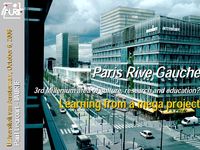Paris Rive Gauche - 3rd Millenium area of culture, research and education ?
Paris Rive Gauche (1990-2020) is one of the most outstanding urban developments in the Paris Region aiming to focus regional development towards the East. Along the banks of the Seine, on the edge of the City, a series of railtracks are being covered since the mid-'90s to make way for a new mix-use dense urban district around the French National Library. Despite early difficulties, the site is being gradually developed in an area for housing, business, research, education and culture, with the new Paris Biopark devoted to mature biotech firms and a new university campus imbedded in the urban and social fabric. Whether the blend is succeeding is a matter of debate, but this is strongly related to the project's governance and organization.
The presentation shows the historical and planning context and gives an insight into the urban design, the delivery -backed by strong public agency, and the public participation on the project. It also draws some lessons from its achievements and drawbacks.
This presentation on Paris Rive Gauche was first shown and debated in Amsterdam at the International Lecture Series (Autumn 2006) "Strategic projects as leverage for transition to the 21st-century urban region" organized by the Foundation for Lectures on Intensive and Multiple Land Use (sLIM), founded by the Dutch Council on Tall Buildings and the Ministry of Housing, Spatial Planning and the Environment).
Acknowledgments
IAU île-de-France wishes to thank Gilles de Montmarin, SEMAPA (Société d'Économie Mixte d'Aménagement de la Ville de Paris) ; Pierre Micheloni, APUR (Atelier Parisien d'Urbanisme) ; Fabrice Piault (Tam-Tam association) ; Willem Salet, University of Amsterdam (Amsterdam Institute for Metropolitan and International Development Studies, AMIDSt).
This study is linked to the following theme :
Urban planning

